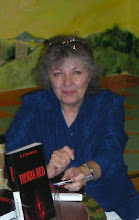
The largest pure gypsum dune field in the world is located at White Sands National Monument in south-central New Mexico. The dunes cover an area of 275 square miles, 115 square miles of which are located within the White Sands National Monument. President Herbert Hoover proclaimed and established the monument in January, 1933.
Lily's harrowing escape from the catastrophic events that occur in Part One of Tierra Red culminates in her being stranded in these dunes. It is here that she discovers the treachery behind her arrival in the Territory of New Mexico.

I found a wonderful old legend concerning the White Sands Desert on the National Park Service website -- a ghost story!
The Legend of Pavla Blanca
To the Indians of central New Mexico, one of the most enduring legends is that of Pavla Blanca, the ghost of the Great White Sands. Hidden behind the swirling eddies of the spectral white dunes, her tragic story provides one of the most fascinating tales of the Southwest.
In early 1540, a valiant, young Spanish conquistador, Hernando de Luna, left his lovely betrothed, Manuela, in Mexico City to accompany the famed explorer, Francisco Coronado. Searching the uncharted lands in present day Arizona, New Mexico, Kansas, and Texas, Coronado followed every Indian clue, every tale, looking for the fabled Seven Cities of Cibola and Gran Quivira, where the houses were said to be studded with gold and the streets were afire with jewels.
Ambushed by the fierce, proud warrior Apaches on the edge of the Great White Sands, the Spanish battled for their life. Exhausted and beaten, the survivors fled southwest to Mexico City. It is said that Hernando de Luna was mortally wounded and perished somewhere in the ever-shifting white sands. Setting out to seek her betrothed somewhere north of what is now El Paso, Texas, the lovely Manuela was never seen again. It is said that the ghost of this beautiful Spanish maiden haunts the dunes of the Great White Sands. She comes nightly in her flowing, white wedding gown to seek her lover, lost and buried beneath the eternal dunes. Some say the ghostly figure usually appears as the evening breezes sweep and dip over the stark white dunes, just after sunset.
The moderns have it that Pavla Blanca is caused by a prevailing wind sweeping over the hushed and lonely desert in the evening, whipping wraith-like eddies of dust. But the Indians say it is the ghost of Manuela, still eternally seeking her lover.
Fact or fiction, those with imagination, strolling in the silent shimmering dunes after a fiery sunset may be fortunate enough to witness for themselves the unusual sight. Thus, this legend persists for some, even to this day. This is Pavla Blanca.









